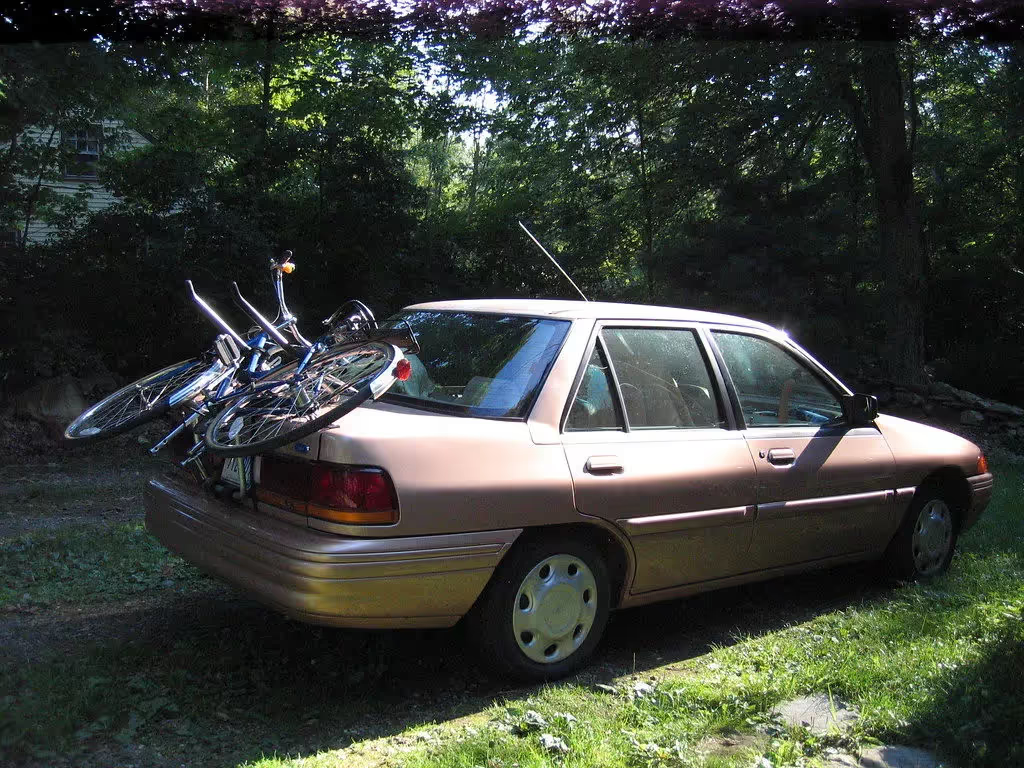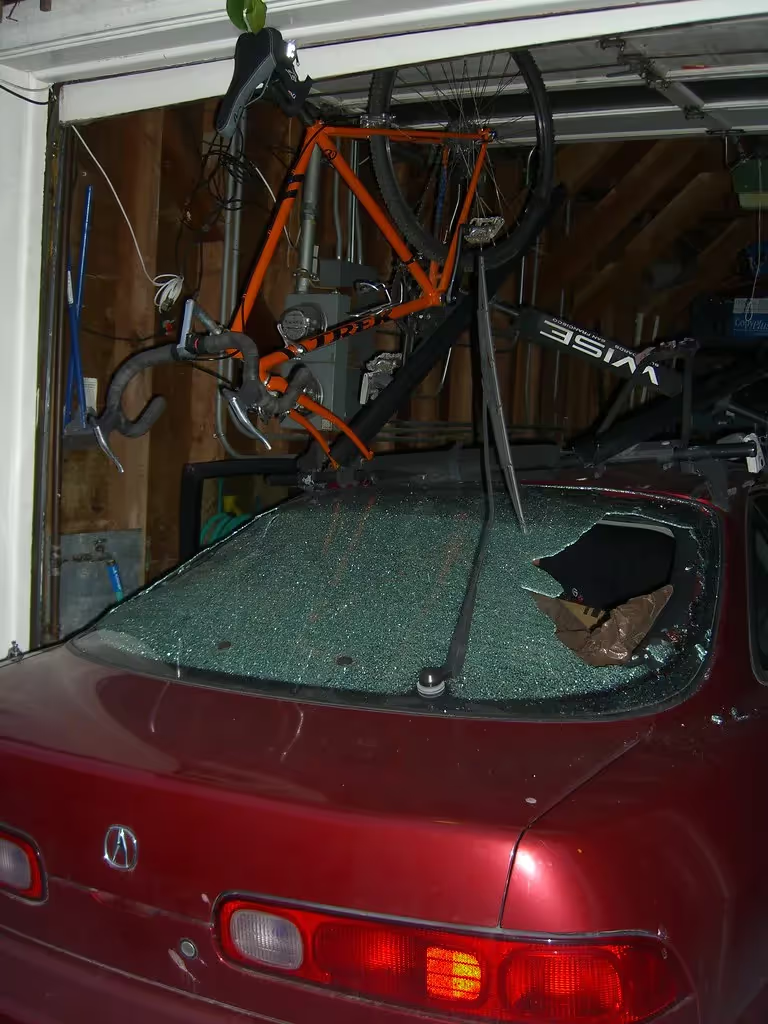Can a Bike Rack Damage My Car? Here's how to Protect it!

With my background as a former REI sports merchandiser, and my experience with product recalls, I've got the inside track on the right installation, maintenance and choosing the right gear for every expedition.
Bike racks are extremely useful for transporting bikes, but can be using a bike rack actually damage your car?
Whether you're a weekend warrior or a daily rider, ensuring your car remains dent, scratch and damage free is crucial.
Improper installation, use, or maintenance of a bike rack can cause damage to your car.
Some types of bike racks have greater chances of causing damage, so this article discusses the potential damage that can be caused by each type of bike rack and how to prevent it.
Using a bike rack can actually cause damage to your precious car. And trust me, whether you're cruising in a sleek sports car or a luxurious ride, you want to keep it in pristine condition.
In this article, we'll explore the potential damage that different types of bike racks can inflict on your car and, most importantly, how to prevent it. From improper installation to maintenance mishaps, and common pitfalls, we'll cover it all.
How to Prevent a Bike Rack from Damaging Your Car
There are many different ways to prevent a bike rack from scratching your car. Following these tips can potentially save you hundreds of dollars in repair bills!
1. Install Your Bike Rack Properly
One of the best ways to prevent a bike from damaging your car is by installing it correctly.
You should closely read and follow all instructions for installing and using your bike rack. All bike racks have different instructions, so be sure to carefully read the installation guide provided with your bike rack.
If you’re having trouble with your bike rack or you’re not sure it’s properly installed, take it to a nearby bike shop and have them install or check it.
2. Double-Check Everything Is Secure
Take extra time to double-check (or triple-check) that your bike rack is secure and stable. This also applied to the bikes themselves.
It is absolutely worth checking the rack several times over, as it could prevent the bikes from falling off, damaging the bikes and potentially the car.
Check the sturdiness of the rack and bikes, the straps, and any other parts associated with your particular bike rack. You can even create a checklist if you use your bike rack frequently to make sure you’ve attached everything correctly.
3. Be Aware of Your Bike Rack
This is most important for infrequent users of bike racks. Having a bike rack attached to your car, whether it’s on the back or the roof, changes the dimensions of your vehicle.
If you have a rear-mounted bike rack, you should give yourself more room in the back when reversing. Take note of how far the bike rack extends from the back of your car. Keep reminding yourself that you have a bike rack attached to the back so you don’t forget and back into another object.
If you have a roof-mounted bike rack, you should know the clearance of your vehicle. If you’re not careful, your bikes can catch against low objects, such as a garage or drive-thru.
Most drive-thrus and low bridges show the clearance on a sign, so they are easy to avoid if you know the clearance of your car with the bikes attached.
If you’re unsure if your bike rack will clear an object, always stop the car (pull over if on a public road) and check if your car will pass through without hitting the bikes. Never take a chance!
4. Clean Trunk-Mount Contact Points Frequently
If you have a trunk-mount bike rack and installed it correctly, you should ensure that the contact points, such as the foam pads, are clean. This includes the surface of the paint that it is sitting on top of.
If there’s dirt trapped under the foam, it will rub against the paint and scratch it like sandpaper. Dirt will accumulate over time, so you should clean these contact points often to avoid damage.
5. Use Painter’s Tape or Paint Protection Film
If your bike rack is rubbing against a certain part of your car, consider protecting the spot using painter’s tape or paint protection film. You will most likely encounter this problem with a trunk-mounted bike rack.
Find the spot where the rack is rubbing against the car and apply painter’s tape or a paint protection film to prevent the paint from wearing down or scratching.
6. Choose the Right Bike Rack
Buying the correct bike rack for your situation can also help prevent damage to your car.
Avoid using a trunk-mounted bike rack if you’re going to be using it frequently. Over time, this type of bike rack can wear down your paint and cause scratches. You should choose one that has large foam pads and thoroughly distributes the weight of the rack throughout many contact points. A trunk-mounted bike can be a good option if you only use it on certain occasions.
Also check out: Best Trunk-Mount Bike Racks
Avoid using a roof-mounted bike rack if you frequently park in a garage.
If you park your car in a garage, you’ll probably have to remove the bikes before pulling in. Not only can this be a hassle if you use your bike rack frequently, but if you forget to remove the bikes it can end up causing lots of damage to your car, bikes, and garage.
Avoid using a hitch-mounted bike rack if you park in the city.
A hitch-mounted bike rack will extend the length of your car and make it more difficult to judge distances when reversing. This makes it easier to hit parked cars, which can cause damage to both cars and your bikes.
You should also make sure your bike rack can hold the weight of the bikes safely. Check the product specifications on your bike rack to find the weight limit. If you’re using a hitch-mounted bike rack, make sure your hitch can support the weight of the bike rack and the bikes combined.
Types of Bike Racks that Can Damage Your Car
Although all bike racks have the potential to damage your car, it is more likely to occur with certain types.
Also check out: Different types of bike racks
1. Trunk Racks
Trunk-mounted bike racks have the greatest potential of causing damage to your car. This type of bike rack sits against the car’s paint and straps to the edges of the trunk.

Since this type of rack is always in contact with your car, it can rub against it and cause scratches.
Trunk-mounted bike racks typically use foam pads to sit on top of the car. These foam pads rub against the paint over time and cause scratches, especially if the bike rack is not secured properly.
If the foam pads are sitting on top of a dirty surface, it can damage your car quicker than sitting on a clean surface.
Additionally, the straps that are attached to the car can rub against the paint. This is more likely to occur if the straps are not fully tightened or if there is an excess strap flying around in the wind.
A trunk-mounted bike rack can also damage your car if the bikes are not fully secure. If the front wheel of the bike is able to move, it can easily rub against the paint while you’re driving. This will surely result in scratches and fading paint over time.
You should also use caution when installing a trunk-mount bike rack to avoid scratching and denting the car. If a hook is dragged against the paint during installation, it could leave a noticeable scratch.
2. Hitch Racks
Hitch-mounted bike racks are much safer than trunk-mounted racks, but they also have some disadvantages.
Although the rack does not have direct contact with the vehicle, the bike can hit the car if not secured properly. If the bike sways or the wheel turns, it can hit the car and cause damage.
You should also use caution when reversing or driving in general. If you accidentally hit something while reversing with a hitch-mounted bike rack attached, it can push the rack into the back of your car or even damage your hitch, depending on the force of the impact.
3. Roof Racks
Roof-mounted bike racks have similar risks to hitch-mounted racks but with some differences.
Instead of exposing the rear of the car to damage, it is possible to damage the roof of your vehicle. It is most important to know the clearance of your car with bikes attached. If you fail to clear a very low bridge, drive-through, or garage, the bikes can be ripped off the rack or pushed against your car.

This can easily dent your car, which can be expensive to repair. It is also possible to smash the rear glass, depending on what the bikes come in contact with.
Final Words on Bike Rack Damage Prevention
It's crucial to consider the potential damage that can be caused by using a bike rack on your car.
Improper installation, use, or maintenance can lead to costly repairs and a dent in your wallet.
Note, that some bike racks have a higher likelihood of causing damage than others. It's important to be aware of these risks and take the necessary precautions. Whether you opt for a roof rack, hitch rack, trunk rack, or spare tire rack, each comes with its own set of pros and cons.
How can you prevent damage to your beloved car? Here is a quick checklist:
- Follow manufacturer's installation instructions carefully.
- Double-check all components for security.
- Regularly inspect bike rack for wear and tear.
- Check straps, hooks, and other components for damage.
- Clean your car regularly to remove dirt and grime.
- Invest in a protective cover or pad for added protection.
- Remove the bike rack when not in use.
With a little knowledge and a dash of common sense, you can safely transport your bikes without damaging your precious car.
Happy biking, safe journeys and breathtaking views.
*proof-read by @Mike Rollins









